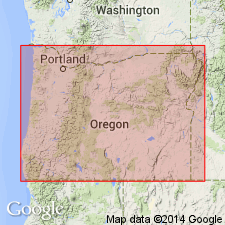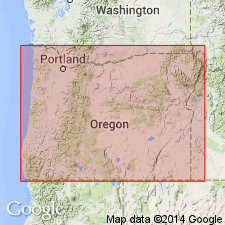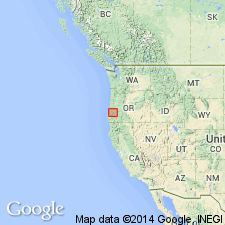
- Usage in publication:
-
- Bushnell Rock Member
- Modifications:
-
- Named
- Dominant lithology:
-
- Conglomerate
- AAPG geologic province:
-
- Klamath Mountains province
- Oregon-Washington Coast Ranges province
Summary:
Best exposed in ridge extending from Tenmile Creek eastward across Porter Creek to Alexander Butte, Douglas Co, OR. Is lowermost of three members of Lookingglass Formation (new). Composed of basal conglomerate containing pebbles to occasionally boulder-sized clasts with medium to coarse sandstone matrix. Conglomerate grades upward into massive sandstone. Beds are thick and poorly stratified. Many pebbles are sandstone, basalt, or greenstone, but some are quartz, chert, and medium-grained intrusive rocks typical of Klamath Mountain terrain. Thickness is 250 to 300 m. Unconformably overlies Roseburg Formation (new). Gradationally underlies Tenmile Member (new) (Lookingglass Formation). Age is early to middle Eocene based on age of Lookingglass Formation.
Source: GNU records (USGS DDS-6; Menlo GNULEX).

- Usage in publication:
-
- Bushnell Rock Member
- Modifications:
-
- Revised
- AAPG geologic province:
-
- Oregon-Washington Coast Ranges province
- Klamath Mountains province
Summary:
Bushnell Rock Member of Lookingglass Formation of Baldwin (1974) included in Umpqua Group. [Author discusses reasons for raising rank of Umpqua.] Shown in stratigraphic columns at Middle Fork Coquille River, at North Umpqua River, and South Fork Coquille River, OR. Overlies Roseburg Formation; unconformably overlies Riddle Formation at South Fork Coquille River. Underlies Tenmile Member of Lookingglass Formation. Age is given as early Penutian to late Ulatisian (Eocene).
Source: GNU records (USGS DDS-6; Menlo GNULEX).

- Usage in publication:
-
- Bushnell Rock Member
- Modifications:
-
- Revised
- AAPG geologic province:
-
- Oregon-Washington Coast Ranges province
- Klamath Mountains province
Summary:
Bushnell Rock Member of Lookingglass Formation of Baldwin (1974) is reassigned as lowermost member (of 4) of Umpqua Formation. Unconformably overlies Siletz River Volcanics in Roseburg and Glide areas and in areas as far southwest as Bushnell Rock. Near Tenmile unconformably overlies Mesozoic chert, greenstone, and graywacke. Underlies Tenmile Member of Umpqua Formation. Age is early Eocene (Penutian). [members of Umpqua Formation are not adopted in this paper; Lookingglass Formation is not recognized]
Source: GNU records (USGS DDS-6; Menlo GNULEX).
For more information, please contact Nancy Stamm, Geologic Names Committee Secretary.
Asterisk (*) indicates published by U.S. Geological Survey authors.
"No current usage" (†) implies that a name has been abandoned or has fallen into disuse. Former usage and, if known, replacement name given in parentheses ( ).
Slash (/) indicates name conflicts with nomenclatural guidelines (CSN, 1933; ACSN, 1961, 1970; NACSN, 1983, 2005, 2021). May be explained within brackets ([ ]).

